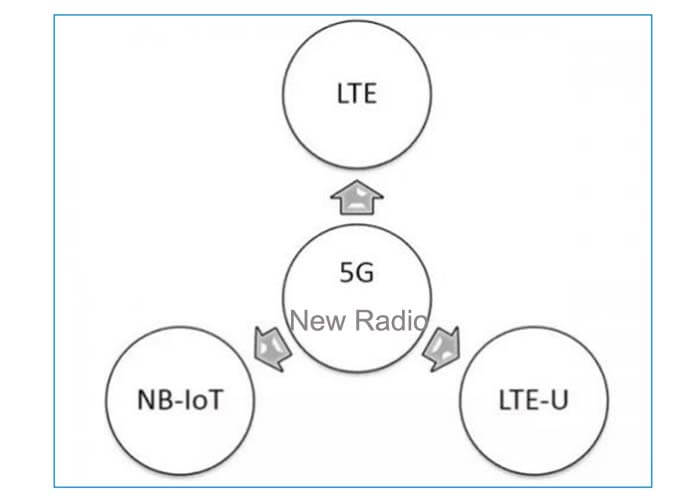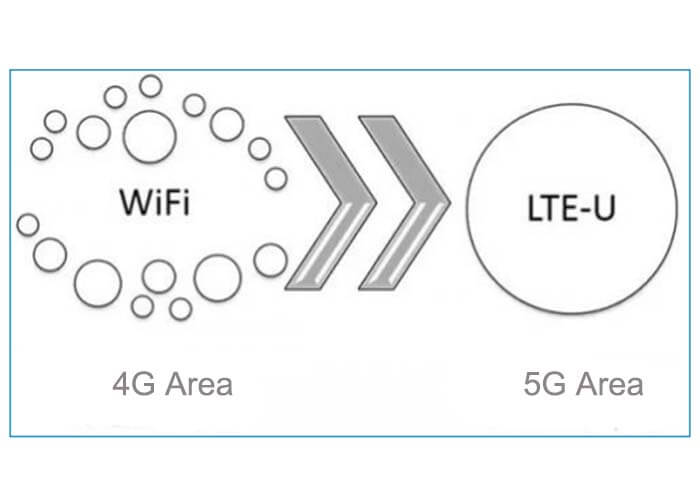What relationship exists between 5G NarrowBand IoT? Whether Narrowband IoT is 5G technology in the end? Today, we will learn about the 5G Narrowband IoT relationship.
What is 5G?
5G in communication, that is, the fifth generation of cell phone action communication standard, also known as the fifth generation of search mobile communication technology.
5G NR technology brings by no means only faster network speed, but will the intelligent interconnection of everything is possible in fact, and NB-IoT is the prelude and foundation of 5G commercialization, therefore, the evolution of NB-IoT is more important, such as support for multicast, continuous mobility, new power levels, etc. As long as the infrastructure such as NB-IoT is complete, 5G New Radio can be truly realized.
5G Narrowband IoT technology brings vitality to innovative applications in the field of IoT, bringing innovative breakthroughs in remote meter reading, security alarms, smart manhole covers, smart street lights, and many other fields.
Industrial IoT is relatively a regional network, so there is a possibility of a breakthrough. NarrowBand IoT bypasses 4G, no need to wait for the arrival of the 5G era all the time, 5G narrowband IoT takes the lead to come out and lead the way.
NB-IoT applications and impact on IoT industry
The development of 5G Narrowband IoT will bring huge changes to the field of IoT, directly affecting everyone’s life. Here are a few typical scenarios and changes.
Smart city: water, electricity, gas meter smart metering, public parking management, environmental protection monitoring and other areas as the entry point, the city public services and public management capabilities to improve, monitoring a city needs many aspects and to low cost.
NB-IoT and LTE make it possible to control street lights, free parking, environmental monitoring, etc.
As mentioned earlier, 5G Narrowband IoT modems are competitively priced. For example, modules are expected to be $5. The main requirement for smart meter reading is network coverage.
Sometimes, the meter reading is required in areas with poor signals, e.g., remote areas and underground, and Narrowband IoT enables monitoring of gas and water meters through regular small data transmissions. This leads to better network coverage.
Three standards in the new 5G era
There are three standards for the New 5G, namely LTE (authorized channel), LTE-U (unlicensed channel), and Narrowband IoT (authorized channel).

LTE belongs to the authorized channel. The standards are mainly being done by telecom operators, and Huawei is also pushing them. As the authorized channel is basically exclusive, for example, given to the power microwave, others cannot use it. This is a monopoly resource for operators, and can only be operated through operators.

The most popular Narrow Band IoT still belongs to the authorized channel, and the biggest feature of NB-IoT is that the transmission distance reaches an amazing 10km, which can cover a small county. And it can take countless terminals, one base station can take more than 200,000 terminals.
This means that managing a manhole cover and parking fee becomes easy and cheap. Even if a base station is built with 2 million RMB, it can be managed in a 10km radius.
Of course, since 5G Narrowband IoT is a licensed channel, it is still unlikely to be used in enterprises. So 5G Narrowband IoT can only be connected to the core network (operator) first, and then enter the enterprise.
Only 5G can solve industrial Ethernet
Compared with general Ethernet, industrial data transmission requires high real-time. Industrial Ethernet has QoS (Quality of Service Protocol), so it is not easy to lose packets when delivering real-time data.
This is because QoS supports prioritization and is able to identify the priority level of delivery, e.g. whether it is voice, or mail, automatically. Voice has high real-time requirements and packet loss causes noise; while TV loses packets and is garbled.
These are unacceptable. Real-time video must have QoS, and images are often the most bandwidth-consuming content to transmit.
The reason why 4G cannot be used for industrial Internet is that there is no QoS, except for voice with recognition, which is arguably a standard IT network. 5GNR, on the other hand, can support prioritization, such as device state being the highest priority, while prioritizing general data delivery at the end.
So it’s worth looking forward to the fact that 5G is the foundation of the industrial Internet. At 40% today, it is basically capable of being implemented (saying 100% is still a bit of an exaggeration).
4G can only go up to 450M, while 5G’s LTE can reach 450M~800M, and more importantly, the selectivity increases dramatically.
4G era technology is mainly Qualcomm; while in the 5G era, Huawei, Cisco, Siemens, etc. have their own technology. This time, the industry can have more choices.
5G Narrowband IoT technology cannot rot in the hands
LTE is a carrier standard and is unlikely to be allowed into the enterprise, so it’s impossible to go and build an iPhone 7 base station. But since the 5G standard and mass placement is still to come.
So the technology began to morph and evolve, for example, LTE has an improved version, and Huawei has taken the lead in launching the so-called enterprise version of LTE technology (eLTE).
It has two frequency bands, one band is 800 MHz (currently allocated to Unicom), and another band is 900 MHz, which is FM. This band can be used to complete the carrier frequency of eLTE, which means it can do the application of the enterprise side.
Based on the same consideration, eLTE-IoT is exactly a variety of 5G narrowband IoT. This can enter the factory and become the IoT cornerstone of smart manufacturing.
Importantly, eLTE-IoT has a cheaper cost, so eLTE-IoT is the first to enter the industrial field.
The outstanding features of eLTE-IoT itself (small power consumption, many terminals, long-distance) make it one of the best 5G first positions for industrial parks. eLTE-IoT, as an unlicensed channel with 200,000 bandwidth, has very little power, no more than 200mw power. Therefore the park establishes this kind of base station and also does not affect each other
At present, eLTE-IoT has started gradually enter the factory and become the best means to deliver IoT data. It will effectively replace RFID, device networking, and other fields, and become the new joy of IoT in smart factories.
C&T RF Antennas Inc manufactures the 4G LTE 5G Narrowband IoT antennas, contact us for more antenna specifications.
You may also be interested in the below articles.
What is the difference between WIFI and WLAN?
Summary of 41 Basic Knowledge of LTE
What Is The 5G Network Slicing?
